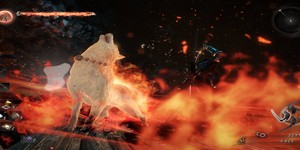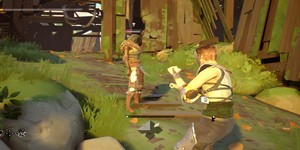
Dark Souls III Review
Price: £39.99Developer: From Software
Publisher: Bandai Namco
Platforms: PC, Xbox One, PS4,
Version Reviewed: PC
Lothric Castle towers over the realm of Londor, built atop a gigantic stack of ancient volcanic rock. The meandering walls and jagged spires stretch right across this bare, foreboding mountaintop, visible for miles upon miles from the surrounding landscape.
Wherever you go in Dark Souls III, the mighty walls and towers of Lothric are never far away. When you emerge from a long and treacherous expedition deep underground, the Castle will be there, its hazy outline in the distance behind you. When you clamber the dizzying heights of the Cathedral of the Deep, the previously hidden castle suddenly reveals itself, awash in the dim glow of Londor's ember-like sun.
Lothric Castle is a constant reminder of both how far you've come in Dark Souls III, and how far you've yet to go. It's the symbol of everything you're fighting toward, and everything you're fighting against. It bears the unmistakeable signature of From Software's creative director, Hidetaka Miyazaki, the mark that explicitly states how Dark Souls III returns to its roots.
After the first Dark Souls slowly battled its way toward its current reputation as one of the greatest games ever made, Miyazaki stepped away from the series to work on the PS4 exclusive Bloodborne. Dark Souls II was created without him at the helm, and while the sequel has its merits, it is undoubtedly a lesser creation, suffering a troubled development and exhibiting a fragmented, haphazard design. Perhaps most notably, the world of Lordran, which had been so beautifully, subtly coherent in Dark Souls, was not reflected by Dark Souls II's bizarrely inconsistent Drangleic, where an elevator in a towering windmill surrounded by a barren landscape can ascend to the base of a castle surrounded by Lava
Lothric Castle is a bold statement of intent, emphasising a return to the organic coherence of the first Dark Souls. What's more, the overt nature of this statement embodies the game's overarching design. Dark Souls III is just as challenging and complex as the previous games in the series, and re-introduces the first' game's wonderfully interconnected environments. At the same time, however, it trades the subtlety of the original for greater clarity, spectacle, and speed.
This becomes apparent from the moment you step into Firelink Shrine, which has changed greatly since we first saw it in Dark Souls. What was once a slice of green sanctuary is now a throne room built upon a pile of ash. Here you meet a Fire Keeper, who explains your quest with an uncharacteristic frankness. The Lords of Cinder who sit atop these giant thrones have become corrupted and abandoned their duties, and since they refuse to return in life, it is up to you to bring them back in death.
So begins another vast and fiendishly difficult journey, that sees you explore new locations and return to old ones that have been warped by great stretches of time. We won't go into detail about which locations make an appearance, but the message conveyed in the nature of their appearance is clear - although we may attempt to go back to a work's roots, we can never truly "return". What has become old cannot be made new again, but what it can do is end, and make way for something that is new.
This is the fundamental thinking behind many of the game's design changes. We are familiar with Dark Souls' gnomic approach to storytelling and lore, so Miyazaki's response is to make the basics clearer. The game's themes are far stronger and more foregrounded, with heavy references to ash and fire and cinders. One of the most thematically significant changes it to the game's "Humanity" item, which allowed for cooperative play, could be burned in bonfires to make them more powerful, and acted as a cryptic clue to the fate of the human race and their relationship with the old gods of Lordran. In Dark Souls III, humanity has been replaced with "Embers". Embers have the same effect as Humanity, but also greatly increase your HP. The switch from humanity to Embers is also a much more straightforward symbol of what this particular item represents.

MSI MPG Velox 100R Chassis Review
October 14 2021 | 15:04

![Dark Souls III Review [ASAP] Dark Souls III Review](http://images.bit-tech.net/content_images/2016/04/dark-souls-iii-review/dsiii1-614x345.jpg)
![Dark Souls III Review [ASAP] Dark Souls III Review](http://images.bit-tech.net/content_images/2016/04/dark-souls-iii-review/dsiii2-614x345.jpg)
![Dark Souls III Review [ASAP] Dark Souls III Review](http://images.bit-tech.net/content_images/2016/04/dark-souls-iii-review/dsiii3-614x345.jpg)
![Dark Souls III Review [ASAP] Dark Souls III Review](http://images.bit-tech.net/content_images/2016/04/dark-souls-iii-review/dsiii4-614x345.jpg)
![Dark Souls III Review [ASAP] Dark Souls III Review](http://images.bit-tech.net/content_images/2016/04/dark-souls-iii-review/dsiii5-614x345.jpg)









Want to comment? Please log in.